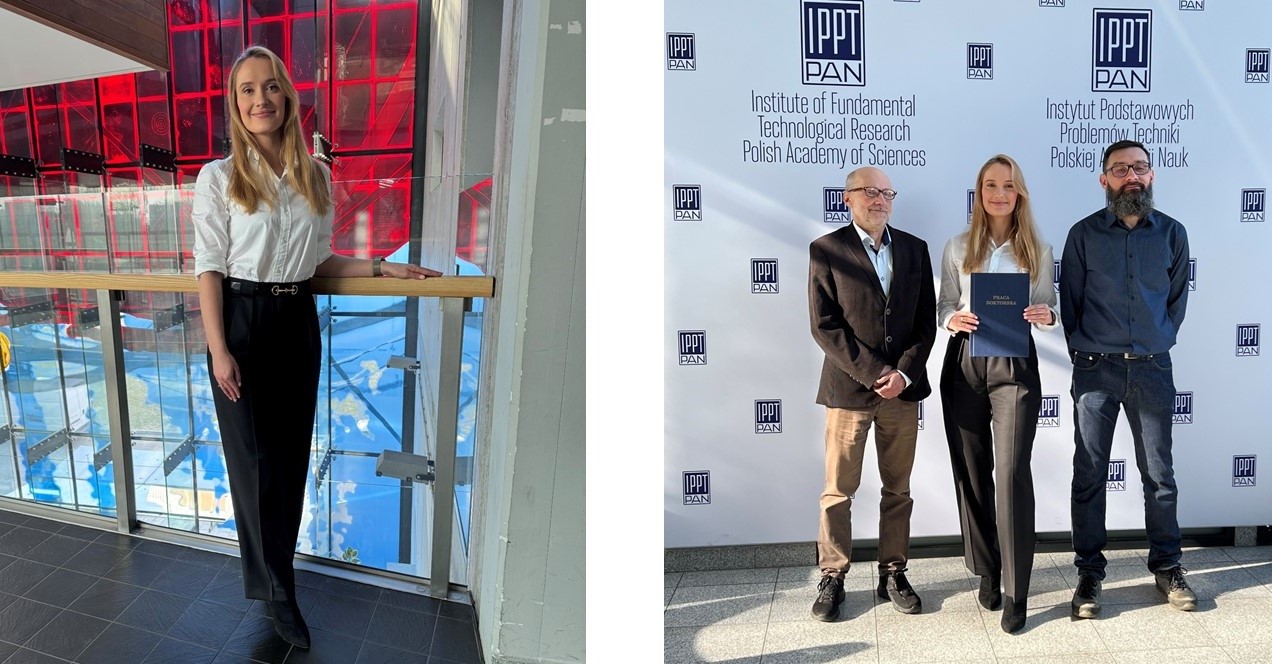On 29 Fabruary 2024, according to the resolution of the Scientific Council of IPPT PAN, Beata Niemczyk-Soczyńska was awarded the degree of Doctor of Science in the field of Engineering and Technical Sciences in the discipline of Materials Engineering.
The following thesis summarizes the studies on thermosensitive injectable hydrogel systems loaded with short electrospun bioactive nanofibers as scaffold for tissue engineering applications/3D cell culture model. The hydrogel system is based on two polysaccharides, consisting of methylcellulose/agarose (MC/AGR) in aqueous solution. The MC crosslinks physically while heating near the physiological temperature, while AGR increases the MC thermal crosslinking rate and mechanical properties of the hydrogel system. In order to provide both, the extracellular matrix (ECM)-mimicking fibrous structure, injectability and biochemical cues, short bioactive electrospun poly-L-lactic acid (PLLA)/laminin nanofibers were added to the hydrogel system. Differential scanning calorimetry (DSC) and dynamic mechanical analysis (DMA) provided information on the MC physical crosslinking mechanism which is, undoubtedly, crucial for fundamental knowledge. Additionally, both of these methods showed that AGR addition increases the MC crosslinking rate. Addition of AGR also improves MC viscoelastic properties, i.e., the final G’ value. Moreover, biological studies revealed AGR contribution in an increased in vitro cellular response and confirmed its non-toxic effect. Optimizing the concentration and ratio between MC and AGR enabled the selection of two compositions that showed the crosslinking rate, viscoelastic properties, and structure adequate for the best support for cell adhesion, proliferation, and differentiation.
PLLA/laminin nanofibers were obtained via electrospinning, and fibres fragmentation took place via ultrasonication. Biochemical cues of short fibres were acquired due to laminin incorporation via physical adsorption. In this part, not only obtained fibres were investigated but also the short fibres fabrication process was optimised and thoroughly investigated in terms of applying different ultrasonication parameters, sonication media and duration of the process. Optimising the short fibres fabrication process allowed the selection of an adequate sonication medium and the relevant fragmentation time. A gel permeation chromatography (GPC) demonstrated that electrospinning and ultrasonic fragmentation do not cause polymers’ molecular weight degradation, while wide-angle x-ray scattering (WAXS) results showed the ultrasonication process could influence PLLA crystallinity. The obtained short PLLA fibres morphology was characterised via Scanning Electron Microscopy (SEM) and the fibers’ average length was in the range of 40-60 μm.
The short PLLA fibers were functionalized with laminin - native ECM protein - via physical adsorption. Water contact angle (WCA) measurements and bicinchoninic acid assay showed that the greatest amount of the protein was incorporated into the PLLA short fibers that had previously been treated with ethanol.
The ultimate MC/AGR hydrogel loaded with short PLLA/laminin fibers was characterized in terms of viscosity, injection ability, morphology and the cellular morphology of L929 fibroblasts, LN-18, and WG-4 glioma cells. The viscosity tests indicated the shear-thinning character of the MC/AGR systems, which increases its tendency with the thermal crosslinking of the hydrogels. Higher viscosity was also observed after short fibers addition to the hydrogel. The injection ability measurements of dynamic glide forces and maximum forces indicate that, depending on the injection rate, hydrogels loaded with short fibers could be injectable via 23G needle. Morphology of the system mimics the native ECM. This result is consistent with the biological studies, which showed that short PLLA/laminin fibers increase the cells-hydrogel interactions, indicated by fast growth and proliferation of fibroblasts and WG4 glioma cells.
The results of the study provide indications that the obtained composite hydrogel is a very promising system as a scaffold or a 3D cell culture model from the perspective of tissue engineering.



















